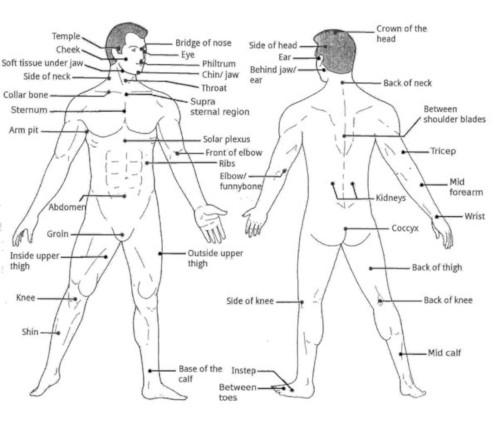Table of Contents
- Understanding Vulnerable Areas of the Attacker’s Face for Maximum Impact
- Techniques to Safely Execute Strikes to the Eyes, Nose, and Throat
- Psychological Advantages of Targeting the Attacker’s Face in Self-Defense
- Training Tips to Enhance Precision and Reaction Time in High-Stress Situations
- The Conclusion
Understanding Vulnerable Areas of the Attacker’s Face for Maximum Impact
To effectively neutralize an aggression instantly, focus on the most sensitive zones of an attacker’s face. Critical areas include the eyes, nose, chin, and jawline – each providing unique leverage for self-defense maneuvers. Striking the eyes can inflict temporary blindness, disrupting the attacker’s focus and coordination. A precise hit to the nose can cause severe pain and disorientation due to the dense network of nerve endings. Targeting the chin and jawline affects the attacker’s balance, often resulting in a stumble or incapacitation.
Understanding the anatomy behind these vulnerable spots is essential for maximizing impact while minimizing risk. When aiming for these areas, technique matters just as much as force. Consider incorporating the following approaches for enhanced effectiveness:
- Closed-fist strikes to the nose or under the eyes
- Open-palm pushes targeting the chin to disrupt balance
- Quick, precise finger jabs to the eyes for momentary distraction
- Elbow or forearm thrusts aimed at the jaw during close contact
Techniques to Safely Execute Strikes to the Eyes, Nose, and Throat
When aiming to neutralize an imminent threat, precision and control are paramount. Executing strikes to sensitive areas such as the eyes, nose, and throat requires an understanding of anatomy and technique to ensure effectiveness without excessive force. For eye strikes, utilizing the fingertips in a swift jabbing motion can momentarily impair the attacker’s vision, providing a crucial opening to escape. Targeting the nose is best accomplished with a sharp upward palm strike or a controlled jab, capitalizing on its sensitivity to disorient and induce pain without causing irreversible damage. Meanwhile, strikes to the throat demand caution; using the fingers or edge of the hand to apply pressure can restrict breathing briefly, creating a vital disruption while minimizing long-term harm.
- Maintain balance and proper stance to avoid overcommitting your motion, preserving your ability to react to counterattacks.
- Use controlled force: Strike decisively but with enough restraint to prevent unnecessary injury.
- Focus on speed and accuracy: Quick, targeted strikes yield maximum defensive benefits without prolonging engagement.
- Follow up with movement: After striking, immediately create distance or disengage to enhance personal safety.
Psychological Advantages of Targeting the Attacker’s Face in Self-Defense
Striking the face during a self-defense situation triggers an immediate psychological impact on the attacker. The face houses sensitive and vital areas such as the eyes, nose, and mouth-regions that directly affect cognitive processing and sensory input. Disrupting these functions can cause a momentary lapse in the attacker’s focus, granting the victim crucial seconds to escape or further protect themselves. This sudden mental disorientation often leads to hesitation or withdrawal, decreasing the likelihood of continued aggression.
The face also serves as a primary identifier for social interaction, and an unexpected strike challenges the attacker’s confidence and dominance. This psychological jolt can induce panic, fear, or shock, making it harder for them to maintain operational control during the assault. Key advantages include:
- Disruption of sensory perception and balance
- Quick incapacitation through surprise and pain
- Undermining attacker’s aggression and willpower
- Enhancement of victim’s psychological empowerment
Training Tips to Enhance Precision and Reaction Time in High-Stress Situations
Enhancing precision under pressure demands consistent practice that mimics real-life scenarios. Incorporate drills that emphasize target focus and muscle memory, such as using reaction balls or laser training tools to hone accuracy on rapid strikes. Integrate visual and auditory distractions to simulate stress, forcing your nervous system to adapt and maintain sharpness. Additionally, practicing slow-motion strikes before increasing speed can build control and reduce the likelihood of missing critical impact zones.
To improve reaction time, engage in interval training that alternates between high-intensity bursts and rest, boosting overall agility and mental alertness. Train with a partner who randomly signals attack directions, compelling you to process information quickly and respond decisively. It’s crucial to condition both the mind and body through consistent exposure to stress-induced environments, which helps reduce hesitation and sharpens reflexes when a real threat arises.
- Incorporate varied sensory stimuli-lights, sounds, movement-to emulate chaotic environments.
- Practice trigger drills where you respond instantly to a specific cue.
- Use progressive overload by gradually increasing the difficulty and speed of your drills.
The Conclusion
In conclusion, understanding the importance of targeting an attacker’s face in self-defense situations can significantly enhance personal safety and increase the likelihood of a swift escape. While self-defense techniques should always prioritize de-escalation and avoidance when possible, effectively defending oneself with focused strikes to vulnerable areas of the face may provide critical moments needed to break free from an assailant. As awareness and training in these methods continue to evolve, individuals are empowered to take proactive steps toward their own security in an unpredictable world.Check Our Other Blogs
- StunGun – Your Trusted Source for Stun Guns, Laws, and Self-Defense Tips
- PepperSprayLaws – Your Trusted Resource for Pepper Spray Information
- StunGunLaws – Your Trusted Guide to Stun Gun Legality and Safety




